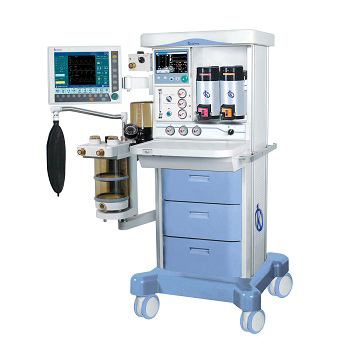Vaporizers are designed to supply the passage of an anesthetic agent from its liquid state to its vapor state, providing vaporization of volatile liquids within an adjustable concentration; which are connected between the output of the oxygen rapid passage and the high quality compensating flow.
On the other hand, an accurate way of administering an anesthetic liquid is to inject it into the anesthetic circuit in known volumes, taking into account its vapor performance. However, in the modern practice of general anesthesia, vaporizers specially designed to evaporate anesthetic fluids precisely and with predictable control of their concentration are employed. These devices for clinical use, are trawl, variable short circuit, specific for each inhalatory agent and placed outside the respiratory circuit, coupled only to the passage of fresh gas, otherwise, would add more anesthetic agent to the gas mixture, which would produce uncontrollable variations in the concentration of inspiratory gases.
Activity of the Vaporizers of the Anesthesia Machine
The anesthetic ventilation system, facilitate the direction of gases plus anesthetic vapor from the anesthesia machine to the patient. Its components include, buffer disk, vaporization chamber, bypass chamber and anesthetic fluid inlet with its closure, to pour the contents of the safe anesthetic agent bottle; which prevents two vaporizers from opening at the same time; in addition to a prismatic glass viewfinder indicating the filling.
Also, the flow of fresh gas that enters the vaporizer, arrives from the flujometers, entering through the inlet mouth, which passes through the vaporization chamber where it is enriched or saturated with liquid anesthetic vapor that is continuously vaporized and directly crosses the short circuit chamber or bypass channel, mixed with the one that leaves the chamber, resulting in the desired concentration. Vaporizers are graded for a given anesthetic gas, but do not vary in their internal structure.
Location of Vaporizers
These vaporizers are located in the airway of the respiratory gases, which are identified as vaporizer generics within the circuit; which allows to know the anesthetic concentration delivered by the same. This is because the circulation of exhaled gases through the vaporizer, feeds back the concentrations causing unsuspected increases of them.
In another order, they require a minimum of care to ensure their proper functioning. It must be cleaned and calibrated at least once a year, to maintain the accuracy of the adjustments. The lack of maintenance can cause the internal obstruction of its parts (fuses), or the wear of important parts for its proper function, preferably the vaporizer should be fixed to the anesthesia machine and in horizontal position, outside the breathing circuit
Maintenance of the Vaporizers of the Anesthesia Machine
Vaporizers should be subjected to corrective and preventive maintenance annually by specialized personnel, which should be repaired and calibrated, for greater safety of the anesthesiologist who operates it. Therefore, the following maintenance parameters are met:
- The vaporizer should be loaded exclusively with the indicated anesthetic.
- Avoid removing the labels that identify the anesthetic to be used, as well as those that indicate some other vaporizer data.
- Carefully pack for transfer, separated from any other equipment, using impact absorbent materials. Make a secure closure of the packaging and identify it correctly.
- It should be placed upright at least 10 (ten) minutes before being connected to the patient.
- It has to be kept in an environment with temperature between -20°C and 50°C (-5°F and 122°F).
- It is harmful, the presence of liquid in the vaporizing chamber may harm the patient or may cause corrosions (e.g. due to water) that alter the functions of the vaporizer.
Anesthesia machines brand Kalstein
At Kalstein, we offer you the appropriate anesthesia machine for the administration of inhalation anesthesia for adult, pediatric and neonatal patients, in which all main ventilation modes are available, such as assisted ventilation, control and assistance-control. It offers full control and has a clear screen interface to help perform high-quality anesthesia administration and management. It offers a high precision output of only 20 ml. It has automatic current volume and compliance compensation. Check with spontaneous and manual respiratory VM monitoring. It comprises the electronic PEEP function in which it uses sterile autoclaved and latex-free components. They are YR series models, which complies with the EC standard, so customers can feel safe when buying it.
We are manufacturers and we have the best advice to make your purchase the ideal, with excellent prices. For a better experience, visit our catalog at HERE

